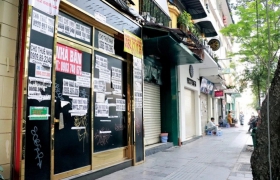PARIS
‘Having a Meal Delivered Is Not Life.’

The celebrated chef, Alain Ducasse, has shifted to takeout at his bistro Aux Lyonnais in Paris. Joann Pai for The New York Times
In normal times, the restaurant Aux Lyonnais is a go-to place for the classic Paris business lunch of comfort and conviviality. Close to the Paris Stock Exchange and the offices of Le Figaro newspaper and the Agence-France-Presse, this bistro in an 1890s building filled up every day with business executives, journalists and government bureaucrats eager for old-fashioned, Lyon-style cooking and loud laughter.
These days, Aux Lyonnais’s blood-red facade looks the same, but inside, it is quiet. The simple iron-framed oak tables are naked without their runners, place settings and balloon wine glasses. Some of the bistro chairs have been put into storage. The zinc bar has been polished. The oversize beveled mirrors, creamy white moldings and green and rose-colored floral tiles have been scrubbed clean, awaiting the moment when restaurants in Paris can open.
And Alain Ducasse, Aux Lyonnais’s owner, looks a bit lost. Over the years, Michelin has showered him with stars; the rich and powerful have flocked to his restaurants in France and around the world. Between 40 and 60 percent of the clientele at Mr. Ducasse’s establishments in Paris — his three-star namesake at the Plaza Athénée, his two-star restaurant in Le Meurice hotel, as well as Aux Lyonnais, Ducasse sur Seine, Rech, Benoit, Allard, Spoon and Cucina — were tourists.

Marvic Medina Matos, above right, in the restaurant kitchen, is the chef who has created a new menu of healthy fare for “Naturaliste,” which Aux Lyonnais has temporarily turned into. Joann Pai for The New York Times
The pandemic upended his world, indeed the world of cuisine in all of France; restaurants and cafes throughout the country are shut tight; there is no road map for when they might reopen.
Like many chefs here, Mr. Ducasse, 64, has turned to takeout (either for delivery or “click & collect”), but not just any takeout. He turned Aux Lyonnais (temporarily) into “Naturaliste” and transformed the kitchen that once served classics like pike quenelles with crème fraiche-heavy Nantua sauce and calves’ liver with parsley and potatoes into a staging area for what he calls “healthy” fare — no meat, salt, sugar or dairy and heavy on fish, soy, fruits and vegetables.
A starter is 6 to 9 euros (or about $7 to $11), a main course 12 to 14, dessert 7. Dozens of boxes filled with meals to be delivered are piled high (100 to 150 every day) along one wall of the restaurant.
“I like extremes,” he said.

Naturaliste’s Marvic Medina Matos, a 25-year-old chef from Peru, and her staff have concocted a menu that includes ceviche with butternut squash, red onion and hummus; beets with smoked eel, cabbage and pine nuts; roasted apple with ginger, a chestnut emulsion and caramel coffee; and a mousse au chocolat with soy milk. The idea is to create entirely new menus that can be prepared in advance.
The day begins at 9 a.m., when Ms. Medina Matos arrives with most of her six-member team. Naturaliste’s 11 independent wholesale vendors — including for fish, grains, seasonal fruits, vegetables and eggs — make their deliveries early, either every day or every other day.
The team dons white chef jackets and aprons and divides up the work. One pastry-chef-in-training takes charge of the starters and makes the ceviche. Another young chef oversees the main courses, makes a broth with onions and carrots, chops chard and adds lentils. An apprentice who handles desserts, concocts a crumble with rice flour and a marmalade with lemon and kiwi fruit.
The process goes quickly. Once the order ticket is printed, Ms. Medina Matos announces it out loud; the kitchen team answers “Yes!” The dishes are ready in three to four minutes.

Naturaliste dishes include white fish ceviche, stewed chickpeas, squash, octopus, soft-boiled egg and caramelized dried fruit. Joann Pai for The New York Times

A vegetable soup with smoked herring is meticulously prepared at Naturaliste. Joann Pai for The New York Times
All take responsibility for moving the dishes into boxes made of cane sugar pulp; the cutlery, which comes in an envelope with the phrase “Naturaliste” on the front, is made of bamboo. An operations manager bags the boxes and handles the deliveries via a number of services, including resto.paris, supported by the City of Paris.
For the moment, takeout is keeping at least a few of Mr. Ducasse’s staff employed and perhaps bringing in some money. But dining in Paris is about the food, of course, and it is just as much about “le partage,” the shared experience of celebrating together in a restaurant space.
“When you get six people around a table in France for a good meal, the ritual starts,” said Mr. Ducasse. “You open a bottle of Champagne. Then you discuss what you are going to eat. Then you order, and when the food comes, you discuss what you are eating. Afterward, you discuss what you ate. And finally, you talk about what you will eat next week. People want to socialize over a bottle of good wine, to look at beautiful, well-dressed women, not to just sit at the kitchen table looking at their spouses.
“Having a meal delivered to your kitchen is not life.”









































































 Yahoo:
Yahoo: 